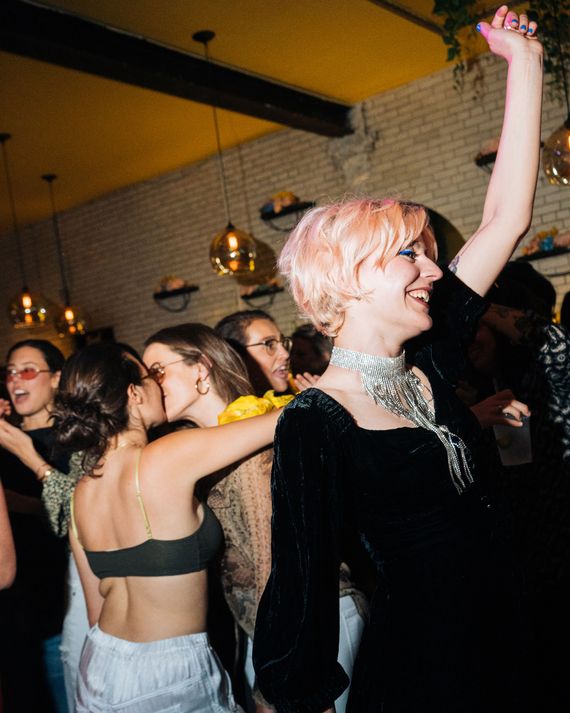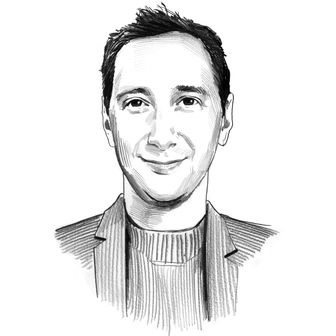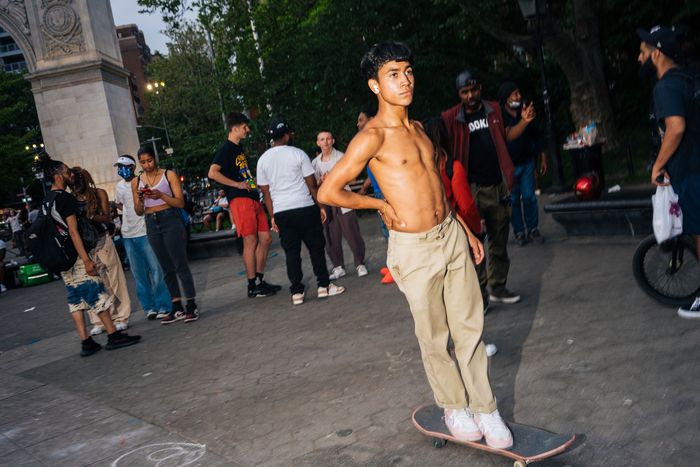
Something happened in May. Or rather, a bunch of things started happening. Again. After spending much of the past year on the sofa, my social life reduced to a few close friends and family members, I suddenly had something to do every night of the week — maskless, outside my apartment — whether I wanted to or not. I was thrilled and afraid to say no to any of it: dinners with people I had not seen in person in months, which could be indoors or out; the opening of a new shop selling trompe l’oeil ceramics and vintage glass (“To release!” two guests toasted, clanking together their White Claws); another friend’s comedy show; a Park Slope after-party; a fancy daylong picnic upstate.
But there were also the things I wasn’t invited to that clogged my phone’s interminable scroll: the rooftop pandemic-baby showers; delayed multi-person makeup birthday parties; and sweaty, hundred-strong club nights. Any conversation might reveal that the couchlock of 2020–21 was no longer in effect. New York City is becoming itself again: crowded, busy, and competitive. “Over the course of the game, texting friends,” a Knicks fanatic I hadn’t seen in a year told me when we ran into each other during playoff season, “it became clear that everyone was at Madison Square Garden but me.”
The pandemic had tamped down just this kind of social triangulating. Pod life simplified things. This could be a relief, even a revelation. “Turns out I’m perfectly happy only speaking to, like, three people for months at a time,” said a woman I know who spent the past year nesting at home, pandemic-pregnant with her second child, while her husband worked in the emergency room at Bellevue. Only later did she realize that, for most of a year, she had not suffered the pangs of FOMO — “fear of missing out” — because sitting at home was what everybody was doing. And, in fact, the FOMO economy collapsed. Ask Patrick McGinnis, the venture capitalist who coined the snack-size acronym in the pages of the Harvard Business School student newspaper in 2004, who had cause for concern. By cosmic misfortune, McGinnis, who has a parallel career as a pop entrepreneur and a podcaster, published his official treatise on FOMO in May 2020, right in the midst of the pandemic. “I thought to myself, Oh God,” he told me. “I’ve become super–irrelevant overnight.”
But not so fast. In April of this year, the canaries in the coal mine started to chirp. Vaccines were going into arms, and social life was creeping back. One of the city’s most FOMO-driven subcultures is the art world. So when, in early May, Frieze unfurled at Hudson Yards — which only months before had been a weird wasteland with its own towering shawarma Ozymandias — with Vaxxed Important People dinners afterward, I knew something was being reawakened. Some of the first parties I could remember hearing about in months were happening. “The entire night, people were just like, ‘It’s the first time I’ve gone to any events with more than, like, two people in a year,’ ” Nate Freeman, the art-world reporter and gossip columnist, told me about the Frieze bash he hosted on a Tribeca-hotel rooftop. “I can understand people’s apprehension. But the biggest backlash was from people who weren’t invited.” When the crowds were hustled home at 11 p.m., an overstuffed elevator got stuck, requiring Fire Department intervention. Four months ago: potential tragedy. Today: farce!
In mid-May, the CDC updated its guidance to say that “fully vaccinated people can resume activities without wearing a mask or physically distancing” (except where prohibited by “federal, state, local, tribal, or territorial” laws), and the dam broke. By early June, Governor Cuomo relaxed restrictions, and, on cue, my phone buzzed with a text, unbidden, from the Pilates place I’d last seen during the Trump administration: “Hot Girl Summer Take.” All the invitations, the commitments, the double bookings, and the RSVPs came flooding back. They hadn’t been banished; they were only hibernating. And now here they were, good as new, as if we hadn’t had the time to philosophically reconsider our priorities after all. “Our message is simple. It’s time to reenter society,” Cuomo said at a press conference in early June, as a screen flashed IF YOU WANT TO START LIVING AGAIN … DO IT IN NEW YORK.
FOMO might have gone into hibernation for a while, but we may now be on the way to a new golden age as we try to make up for the year we lost by doing more than ever. (McGinnis is booked back-to-back now: “The amount of press and speaking inquiries that I’ve gotten just in the past six weeks has been the most I’ve had in my career.”) It couldn’t be otherwise. The city runs on FOMO, a connoisseurship of opportunities and possibilities; the catechism of “Did you get invited, are you on the list, can you get a table?”; the performance of plans.
Remember plans? All across town, plans are once again abloom, plans polliniferous, begetting others, which beget others. The city is Rip Van Winkling into wobbly wakefulness. The pandemic rages on in many places, and its traumas will haunt us for years, but in New York City, at one point among the hardest-hit places in the world, vaccinations are up and cases are down — down far enough that we are invited to tiptoe back into public life, paler and weirder than we left it. As Memorial Day approached, city tollbooths clocked traffic at pre-pandemic levels. Over the holiday weekend, rain notwithstanding, 10,000 people a day lined up outside the Met. At retailers across America, sales of in-public essentials for a public creeping out of its hermitage are up: teeth-whiteners, deodorant, sunblock, condoms.
If you doubt it, check your Instagram, where you can watch the repopulating of the social sphere in real time, pandemic pods breaking open to reveal new friendships you’d not realized had been quietly gestating during lockdown. We all know — at least for the young, maybe also for the reckless — the parties never stopped, really; now, what was once hidden from judgmental eyes is shared widely. “This happening right at the edge of summer has flipped people out,” said an old colleague when I ran into her at an exercise class. “People are asking me, ‘Do you think I should make a plan for every single weekend?’ There’s so much hedging of bets over July and August people are struggling to commit. The options feel limitless even though they’re just what they were before — which is mediocre.”
Ours will be a rickety reentry. Like Rip, we are unpracticed, we creak. (“As he arose to walk,” his story goes, “he found himself stiff in the joints and wanting in his usual activity.”) But more than that, we are anxious — about being back and not being back. Are all my friends hanging out without me? Have they been this whole time? Now my phone glows with scheduling and agita. “I feel like my feet are rejecting shoes that aren’t running sneakers or Birkenstocks,” a friend recently admitted to me. “When I put on even the tiniest stitch of makeup, I feel like a Kardashian. I know for sure that I don’t ever want to return to the lifestyle of dinner plans on most nights, but I’m so out of practice when it comes to planning that I can’t seem to strike the right balance. Basically I’m lost. I don’t want to miss out, but I don’t want to go out, either.”
All over a jittery city, the excitement of reentry is colliding with the anxiety of abundance.
Lockdown was taxing, sure. “What I found so interesting,” Shannon O’Neill, a psychologist at Mount Sinai, told me, “is that we were instructed to behaviorally mimic symptoms of depression.” But the return may be no less fraught. “It was a shared collective experience that you weren’t missing out; everyone really had to stay home. Now, with everyone being able to pick and choose what they do again, seeing people out on social media — whether you don’t feel ready to go out or you’re quite comfortable with this new way of living — I’m sure that often causes a lot of emotional distress.” You may ask yourself (I may ask myself): How did everyone get these invites? Have they actually been tending to their relationships during quarantine, going to Zoom drinks while I was rewatching The Good Wife? Did everyone get in shape except me?
The only two registers seem to be all or nothing. “I think people emotionally are not ready to go out,” my former colleague said. “People need to ratchet down their expectations or this is going to end in tears. People are about to lose their minds. I’m scared of people’s drinking calibration right now. You need to practice at home first before going out.” She described her own recent history as being booked four or five nights a week; among her friends, plans for a party quickly became hysterical. “What I say to my fiancé is I want to be in a sensory-deprivation tank — as I’m texting people asking what they’re doing. I can’t keep up. I don’t want any more texts. But I’m texting.”
The world has resized, radically. During the pandemic, those of us lucky enough to be able to stay home got used to living smaller, farther-apart lives, shrunk down to the local level. And after months of watching the infection rates skyrocket in cities that opened too quickly, people — at least those over 30, certainly those over 40 — tend to be a bit cautious about rocketing back to the way things were. As recently as February, a Pew survey found that roughly a third of adults felt anxious, nervous, or on edge at least a moderate amount of the time; that is bound to have some lingering effect on us. We all know the toll of the pandemic, the divisions it laid bare and the inequities it inflamed, won’t snap back to normalcy now or soon.
But the new normal is now inexorably giving way to the old normal with an onrush of vertigo, the terrestrial bends. “I had been happy in my little world,” one friend told me. “Now I’m like, Is my world tiny?” FOMO is budding again with the promise of shared experiences, the requisite burden of braving the lines for Alice Neel at the Met to talk about it afterward, Romy Schneider and Alain Delon splashing in La Piscine at Film Forum, if you can snag a ticket. (Even the lines, the snagging: a pleasure.) But it’s a FOMO that has caught us with our defenses down, less sure of what we want or the certainties that supported us going into, or going through, the last drudging months. Do I really want to go back to the old way? Will I be able to continue all the practices I developed in the pandemic era? Does everyone want to do something I now realize I don’t want to do? Do I actually want to do something I didn’t think I wanted to do?
The obvious solution is to do less, to keep some of the guardrails of quarantine life in place as the old ways return. “Philosophically, the pandemic should’ve forced us to reconsider a lot of things,” said the designer Mary Ping, who is such a slow-and-steady type that she named her company Slow and Steady Wins the Race. “Personally, I’m going to be a lot more intentional.” But paring back plans and declining invitations in an attention economy is easier said than done. She said this an hour into a (maskless!) drive north of the city to attend a fund-raiser at the artist Dan Colen’s side-project artisanal farm. The night before, four different attendees texted me anxiously about the dress code. What does one wear to a see-and-be-seen tour of the sties and fields of a working farm in 80-degree heat in the heart of Lyme country? “Am I going to feel foolish in my skort?” is a question I have not been asked in many, many months.
But it wasn’t FOMO, ultimately, that animated the afternoon. It was the peculiar, rusty return of something a lot like joy. “We’re social animals,” said Jon Gray, one of the co-founders of Ghetto Gastro, the Bronx-based food-advocacy group, and a board member of the farm. “I’ve been inside.” The online experience doesn’t compare, especially when you’re seeing people you haven’t seen in two years, even if the old social fluency has still not quite returned. “I think of what Jay-Z once said,” Gray told me, then paused. “Wait. What did Jay-Z once say? The streets … He says something about being married to the streets … ”
He finished it himself: “I’m married to these streets, and I’ve been estranged for a while, so I’m ready to get back out there.”
But slowly, carefully. Now is the interregnum between quarantine and freedom, the old normal, the new normal, and the new new normal, when every interaction is exhausting and yet we’re giddy with the permission to say, “Sorry I’m being weird. I haven’t adjusted to polite society yet.” “If people are feeling a little hesitant, a little anxious or unsettled, I think that that’s quite natural,” O’Neill told me. “Phasing normal feedback into life is just going to take time in some patients.”
I was one of these patients on a recent Monday night when I met a friend for dinner, indoors, in Chinatown. Dr Clark, a Hokkaido-style Japanese restaurant, had been designed to be unbookably thronged and had the misfortune of opening right in time to go into pandemic hibernation. At a little after 7 p.m., with the lone barstool occupied by a kid of about 6, it seemed like the return hadn’t returned yet. But sometime between our cabbage salad and the cooling off of the tabletop grill, the place began to fill, as though it was the 2020 that Dr Clark had prescribed. I felt very glad to have a table and an old familiar itch, embarrassing but undeniable, to snap a photo to broadcast, which I did.
“It’s gonna be a hot dick summer, you know?” an art dealer named Dan told me, sliding into our booth and ordering a mezcal. (The casual intersection of plans, parties, tables? It’s back.) Two tables over, the editors of The Drunken Canal, the DIY broadsheet of Dimes Square, were celebrating a birthday. They had a deadline to meet for the next issue, but work is forever and birthday parties, like New York, are back. “Of course New York is back,” Gutes Guterman, its co-editor, said. “Karaoke is happening.” And so it was, right in front of us, two-dozen people aerosolizing Demi Lovato lyrics to a television above the bar. Remember how reckless karaoke seemed so recently? But eventually the hair on the back of my neck settled down.
“I think maybe we need to build back our social muscles a little bit,” a once-and-future party boy I know opined. “Everyone’s out, and there’s a critical mass, and it’s really fun, but it leads to this thing of like, ‘Let’s go to this place!’ Okay. And then, ‘Let’s go picnic in the park.’ And then, ‘Oh, this person has an art opening.’ And then, ‘Oh, let’s get dinner around the corner.’ And then, ‘That person has a birthday.’ It starts to feel almost like this Fashion Week level of every hour is scheduled.” He described a week of going out four nights in a row and spending the fifth in bed all day. “I needed to be in a dark room,” he said. “I quarantined myself from oversocializing.”






